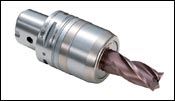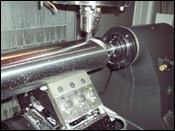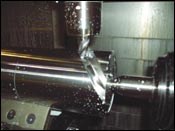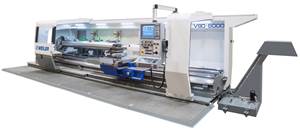Milling Chuck Pumps Up Productivity
Rigid toolholding offers a platform for productivity on this pump manufacturer's mill-turn center.
Peering at the shiny NT4250 DCG situated on Mori Seiki distributor J&H Machine Tools, Inc.’s shop floor, Imo Pump realized that it would need to make some savvy toolholding choices to assume ownership of the nicely equipped mill-turn center. The pump manufacturer had reached a pivotal point in production of a certain screw. In fact, what was called for was a complete overhaul of the current machining process. Capable of turning and milling in one setup, the mill-turn machine could consolidate multiple setups and thus enable the company to streamline screw production. However, implementing the revamped process would hinge on identifying the proper tooling to complement the machine’s ample capabilities.
The Monroe, North Carolina-based shop says its first order of business was to identify a way to hold the tool securely enough during a rough slotting operation, an integral part of the machining sequence. Otherwise, it would not have adequate means to abate vibration and decrease cycle time. Thus, it would not have a way to justify the expense of acquiring the NT machine.
“Initially, we were rough milling these screws using a totally different method,” explains Jonathan Hunter, manufacturing engineer at Imo Pump. “We were using numerous machines to carry out what we can now accomplish with one. Between turning operations, milling keyways and milling threads, I suppose that we’ve been able to eliminate five different setups.”
Ultimately, the shop chose to apply a milling chuck to a distinct spindle interface, a Capto C6 to be exact, to reach higher cutting efficiencies, accelerating cycle times by between 15 to 20 percent.
The particular component is a power rotor screw to be implanted in one of the many screw-type pumps of varying shapes and sizes conceived and manufactured at Imo Pump. Predicated on engineering principles set in place by founders Carl Montelius and Bengt Ingestrom in 1931, Imo Pump is now a division of Colfax Corporation. Credited with the design of the first multiple-screw pump, the company says its rich history of invention continues today, as it produces pumps that operate quietly at high speeds and high pressures in thousands of applications. The manufacturer attributes the widespread use of its pumps to the simplicity of the design. Its products can be found in barges and ships and in engine rooms on commercial marine vessels and combat ships, to name a few.
Commonly made of 4140 steel, the power rotor screw is turned by the motor and drives two idler screws in the low-pulsation pump. Because this screw ensures the smooth operation of the three-screw pump, it is imperative that the shop machine it accurately on a consistent basis. In order to do that, Imo Pump would need to remedy a vexing process segment—a rough slotting operation. The operation involved rough milling the screw threads using a 3/4-inch, four-flute carbide end mill.
“This roughing of the slot, which is a key area of the part itself, was really the driver to make or break the entire process,” comments Jack Burley, VP at Big Kaiser.
The Matter With Chatter
Thus far, the company had not been able to hold the carbide end mill rigidly enough to make the required depth of cut (DOC) and achieve the high speeds necessary to rough mill the threads expeditiously. Realizing that inadequate clamping forces could potentially cause rough finishes, frequent tool breakage and workpiece marring, Imo Pump began a series of trials.
J&H Machine Tools, Inc. performed all of the testing at its Charlotte, North Carolina facility. Over the course of the trials, various seemingly plausible options proved impractical, given the cycle time and concentricity constraints.
For instance, both an end mill holder and an ER collet chuck posed limitations. For this applicaiton, both lacked the characteristics needed to provide the necessary rigidity, which meant running the part slower.
“During roughing, the ER collet chuck was actually pulling the tool out of the holder, making it cut undersize,” Mr. Hunter explains. “The standard end mill holder imposed extra forces on the tool itself. I noticed extra wear on tool while holding in that style. The excessive vibration caused stresses that receded the end mill.
“With this collet style, we could only achieve about half the depth of cut,” he adds. “In addition, we were running slower, and the collet seemed to be marring the workpiece.”
The Right Connection
After weeks of trial runs that failed to meet the predefined operating parameters, the team was open to suggestions. It consulted Richard Bevers, regional manager for Big Kaiser. One facet of the shop’s selection criteria was compatibility with the Capto C6 spindle interface.
As Mr. Burley explains, the Capto C6 interface already provides a foundation for rigidity, which can be enhanced with the appropriate application-specific toolholding.
“This spindle interface consists of a tri-lobed tapered male connection so that when you put it into a receiver there is no drive key per se,” Mr. Burley explains. “The polygon shape is the drive system. Because it is on a slight taper, it precisely locates into a spindle.”
As a licensed manufacturer of Coromant Capto tooling systems, Big Kaiser offers numerous toolholding systems that are compatible with spindles equipped with a Capto interface. After reviewing the application, Mr. Bevers determined that the Mega Double Power milling chuck could potentially rectify chatter issues associated with the other two holders. Supplied from stock, the tool was placed into operation immediately. With the vibration issues remedied, Imo Pump was consequently able to increase the DOC as well as the feeds and speeds.
Better Concentricity
According to the manufacturer, the rigidity of the holder itself and how it clamps on the tool eliminates the vibration. Its locking nut configuration enables the chuck to offer accuracy of 0.0002 inch at four times the diameter, which translates to constant cutting for all flutes engaged in the workpiece.
Rigid clamping begins with the outer diameter of the toolholder, which is said to be completely symmetrical. To tighten the tool in place, the operator need only turn this nut in a clockwise direction with a custom wrench, dubbed the Mega wrench. This wrench fits over the diameter and works as a one-way clutch. It grips the smooth OD without marring or causing indentations on the clamping nut. When the nut is fully tightened, there is double contact between the toolholder body and the nut itself.
“This milling chuck has high gripping force, probably in the order of seven to ten times more than what one might find with a collet chuck,” Mr. Burley says. “It offers excellent runout and higher mass and damping capability when compared to an end mill holder.”
These capabilities, Mr. Burley says, can be attributed to larger mass at the cut (where the tool goes into it) and the construction of how the tool is clamped is so much more rigid, the damping capability of the tool results in smoother cutting.
Mr. Burley approximates that Imo Pump has realized three times more DOC and three times faster feed rate with this tooling solution, compared with the ER collet and the standard end mill holder.
Big Kaiser’s Double Shot (DS) configuration also contributes to noticeable gains in cutting efficiencies at Imo. A standard feature of all Big Kaiser toolholders, this peripheral cooling system propels coolant through the holder, right along the edge of the end mill.
“The body of the toolholder contains holes to allow coolant to pass through,” Mr. Burley explains. “This not only flushes chips but also cools the cutting edge.”
Since May 2007, the mill-turn has resided at Imo Pump’s Monroe facility. Coupling its capabilities with the attributes of the new milling chuck has been instrumental in streamlining screw production. The company cites a setup reduction of 35 percent (on average), in addition to favorable tooling life and discernable leaps in productivity.
“We’ve noticed better life on that particular tool, and we just added another chuck,” Mr. Hunter concludes.
By all accounts, the toolholding itself, though initially more expensive than other options, is earning its keep.
“The tooling has been crucial in delivering a marked improvement in productivity,” Mr. Bevers concludes. “In the long run, those kinds of results are more valuable than saving a few bucks on a toolholder.”
Related Content
Inverting Turning and Five-Axis Milling at Famar
Automation is only the tip of the iceberg for Famar, which also provides multitasking options for its vertical lathes and horizontal five-axis machine tools.
Read MoreBuilding an Automation Solution From the Ground Up
IMTS 2022 provides visitors the opportunity to meet with product experts to design automation solutions from scratch.
Read MoreWeiler to Debut New Automation Features For Its Lathes
Weiler’s V 110 four-way precision lathe introduces features new to the U.S.
Read MoreHow to Reduce Cycle Times by 70% and More on Your Existing CNCs and Dramatically Improve Tool Life Too
By employing advanced high efficiency milling techniques for the entire machining routine, SolidCAM’s iMachining technology can drastically reduce cycle times while vastly improving tool life compared to traditional milling.
Read MoreRead Next
The Cut Scene: The Finer Details of Large-Format Machining
Small details and features can have an outsized impact on large parts, such as Barbco’s collapsible utility drill head.
Read More3 Mistakes That Cause CNC Programs to Fail
Despite enhancements to manufacturing technology, there are still issues today that can cause programs to fail. These failures can cause lost time, scrapped parts, damaged machines and even injured operators.
Read More.jpg;maxWidth=970;quality=90)









.jpg;maxWidth=300;quality=90)












.png;maxWidth=300;quality=90)









